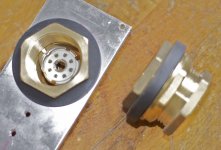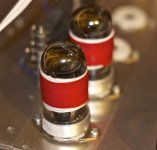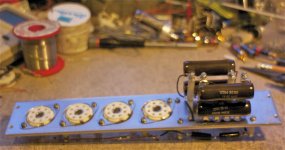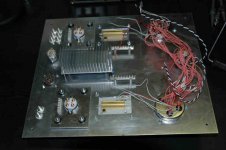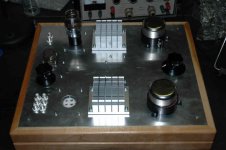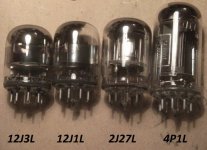Thanks, Andy....
For reference, I have attached a serving-suggestion for the 4P1L in filament-bias, transformer output version.
You can see the degeneration effect of the bias resistor: about 10%, if you choose 15Ω - for a typical bias of 8-9V or so.
4P1L is an excellent choice for experimenting with filament bias. It looks a bit wasteful of power, at first glance - but to get the same level of performance, you would need a separate transformer, rectifier, caps and a very low-noise regulator to generate a fixed-bias supply of equal quality to this circuit. The 3-terminal regulators would be fairly disastrous for this function, too!
Did you consider using the Ultrapath technique to extend bass response?
Hi Michael,
I mount the ceramic valve socket directly with a pair of silentblocks (see link below). They are not cheap but are very effective. You can also make a sandwich of a top plate with a silicon layer in between, this can be effective as well.
This seller is closer to you, so you may find it useful.
Gummipuffer Silentblock Typ A M3 Ø 6 / H 10 Silent Block Bloc | eBay
Cheers,
Ale
I mount the ceramic valve socket directly with a pair of silentblocks (see link below). They are not cheap but are very effective. You can also make a sandwich of a top plate with a silicon layer in between, this can be effective as well.
This seller is closer to you, so you may find it useful.
Gummipuffer Silentblock Typ A M3 Ø 6 / H 10 Silent Block Bloc | eBay
Cheers,
Ale
Hi.
Thank you for your suggestions.
I have my amp in a homemade chassic made of azobe "iron wood". This helped on
the microphonic, and I have ordered the "silent blocks".
Will try to add the "silent blocks" when they shows up.
I have 25 hours on the beast and its getting better.
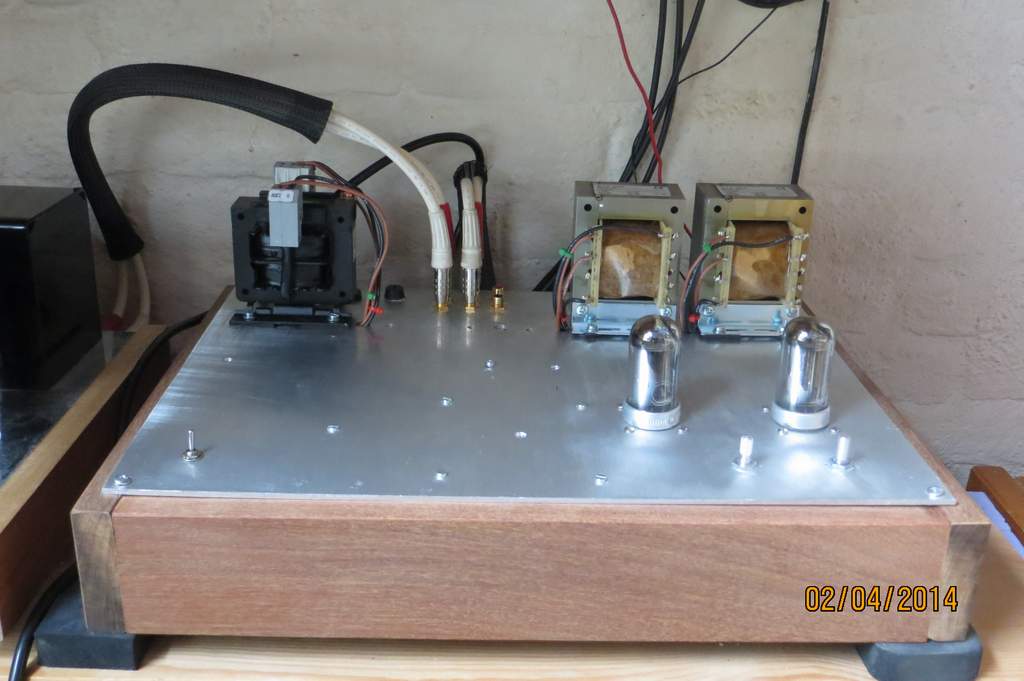
Michael.
Thank you for your suggestions.
I have my amp in a homemade chassic made of azobe "iron wood". This helped on
the microphonic, and I have ordered the "silent blocks".
Will try to add the "silent blocks" when they shows up.
I have 25 hours on the beast and its getting better.
Michael.
Last edited:
Hi Michael,
Try to use suspended sub-chassis.
In the sub-chassis mounting holes I use rubber grommet, and between the sub-chassis and the socket I put rubber sheet.
Hi Euro21...
First i would like to suspend the sockets from the aluminium plate.
Then I'll suspend the trafos from the chassis. Tried with some rubber which
turned out to be quite efficient.
The Silent Blocks would be my choice here.
If I don't play to loud "normal listening level" it's quite okay now.
When I started it was a disaster. Now it's much better.
I really like the sound of the 4p1L. Bass response is way over my wildest
expectations. Midrange and top is starting to be a lot better.
My speakers is a pair of tannoys 385-HPD alnico, in a 303 liter internal volume enclosure. Running on a 2a3 loftin-white amplifier.
Michael.
Hi Euro21...
First i would like to suspend the sockets from the aluminium plate.
Then I'll suspend the trafos from the chassis. Tried with some rubber which
turned out to be quite efficient.
Michael.
Before you do any drastic rebuilding, put the chassis on something really soft and spongy. And wrap teflon plumbers tape round the bottles several times. Remember that there is both air borne and structure borne vibration.
I don't know why you want to suspend the transformers - surely they add mass to the chassis which is good? It's the glass bottles and the filaments in the tube that vibrate.
You could make a subchassis for the sockets - may be overkill. In that case mount the sockets on a double thickness alu, like 8mm. Mass is your friend. You may prefer to use bendy springs to decouple - think Linn turntables.
You need to think a bit about what you are doing here. I know Ale uses the rubber decouplers, and I pretty much have faith in anything he does, but I think it's possible to achieve better decoupling than that by imitating turntables. There's also the SME turntable which used multiple rubber bands. Like the Linn they use gravity to suspend the sub-chassis. And because gravity works better on heavier objects, the mass of the sub-chassis should be robust.
Last edited:
If you still experience that ringing, before you go nuts with construction changes, perhaps you should consider that the problem may not be mechanical. Do you get an equally loud noise when you lightly tap the chassis (with different items)? If not, I would suggest you change the operating point to something more "normal" and see if that changes the ringing behaviour. Do you have grid stopper resistors, with a minimum of distance between grid and resistor? If so, what value?
I don't know which schematic you're using, but oscillation is possible from several parts of the circuit: the CCS, the filament supplies, the tubes themselves.
I don't know which schematic you're using, but oscillation is possible from several parts of the circuit: the CCS, the filament supplies, the tubes themselves.
Hi Andy...
Where do you buy your "teflon plumbers tape" ???
Will try it, just in case... It looks nice on the tubes
I actually did not need to do a complete rebuild.. Just changed the frame.
The "iron wood" seems to work better for me.
Microphonic is not that bad when not playing to loud...
PS! This is only a test model, Think I'll go for 4mm Alu plate, when I have tried
out different options...
/Michael.
Where do you buy your "teflon plumbers tape" ???
Will try it, just in case... It looks nice on the tubes
I actually did not need to do a complete rebuild.. Just changed the frame.
The "iron wood" seems to work better for me.
Microphonic is not that bad when not playing to loud...
PS! This is only a test model, Think I'll go for 4mm Alu plate, when I have tried
out different options...
/Michael.
If you still experience that ringing, before you go nuts with construction changes, perhaps you should consider that the problem may not be mechanical. Do you get an equally loud noise when you lightly tap the chassis (with different items)? If not, I would suggest you change the operating point to something more "normal" and see if that changes the ringing behaviour. Do you have grid stopper resistors, with a minimum of distance between grid and resistor? If so, what value?
I don't know which schematic you're using, but oscillation is possible from several parts of the circuit: the CCS, the filament supplies, the tubes themselves.
Hi.
The Schematic I use is very similar to "Ales" Little Siberian. This is the
LTSpice is use.
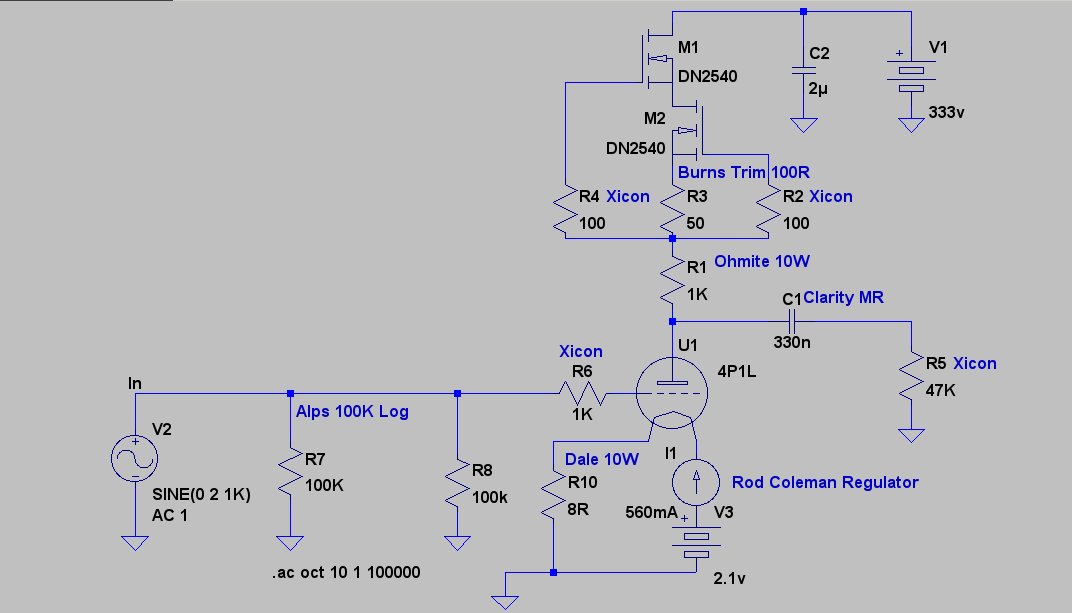
Running 92 volt on Anode..
1.65 volt on Rod Colemans Filament board..
>>Do you get an equally loud noise when you lightly tap the chassis (with different items)?
Yes I can provoke the ringing, When tapping on the chassis.
PS! Quite happy with the sound performance.
/Michael.
Last edited:
Hi.
Thank you for your suggestions.
I have my amp in a homemade chassic made of azobe "iron wood". This helped on
the microphonic, and I have ordered the "silent blocks".
Will try to add the "silent blocks" when they shows up.
I have 25 hours on the beast and its getting better.
Michael.
Maybe these tubes are inherently microphonic and therefore not suitable for audio? Has anyone considered this before?
Hi.
The Schematic I use is very similar to "Ales" Little Siberian. This is the
LTSpice is use.
An externally hosted image should be here but it was not working when we last tested it.
Running 92 volt on Anode..
1.65 volt on Rod Colemans Filament board..
>>Do you get an equally loud noise when you lightly tap the chassis (with different items)?
Yes I can provoke the ringing, When tapping on the chassis.
PS! Quite happy with the sound performance.
/Michael.
Can I ask, what is the purpose of R1 (1K)? I've seen this often when people use this CCS, but it does not appear to be necessary. The resistor does not improve the performance or serve any other function that I'm aware of. Why's it there?
Zdravstvuj Charm,
Do you have any practical experience with stripping metal base from 4P1L, due to the elimination of microphonic?
My experience with some tubes that have a metal base not positive. Glass and socket is a lot of hot without it.
Maybe these tubes are inherently microphonic and therefore not suitable for audio? Has anyone considered this before?
Unfortunately yes, and quite wrongly. Many years ago I got the impression from Klaus on his excellent Russian site that they were too microphonic to use. This delayed my trying them for several years of wasted time. Yes, they're microphonic but only for small signal use. At 2v input they're fine for me - no problems if you construct sensibly. As a driver they're as good as almost anything, and put a couple together and you have a slightly more beefy 2a3 as an output tube.
I can't honestly think of many tubes that are more suitable for the kind of audio I want - directly heated, low plate impedance, moderate current capability and can be easily used in filament bias. Ticks all the boxes, and they sound seriously good, like 2a3 good.
Andy or Ale, I read on Ale's blog that 4p1l gain stage (preamp) with 4p1l power amp is "too much of a good thing"; a bit too bright or revealing in nature? Apologies if this is twisting your words.
Do you guys still feel this is the case, or have there been advances in your 4p1l preamp circuits?
Do you guys still feel this is the case, or have there been advances in your 4p1l preamp circuits?
- Home
- Amplifiers
- Tubes / Valves
- 4P1L DHT Line Stage
